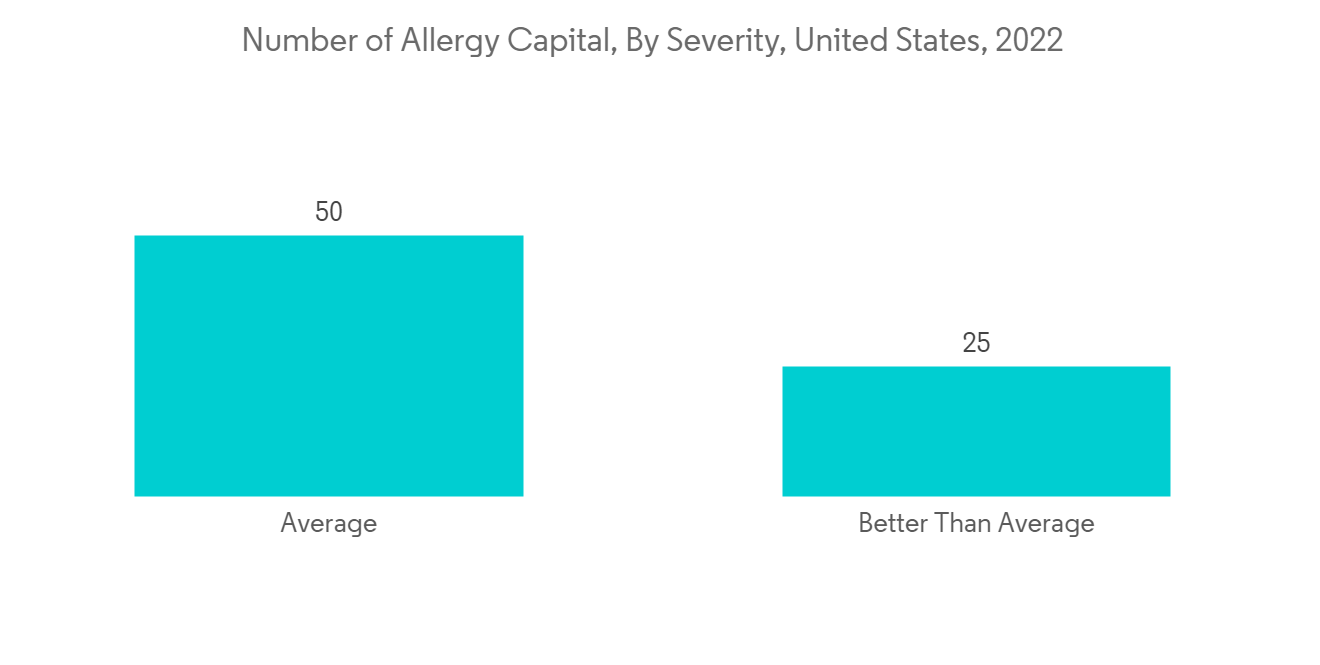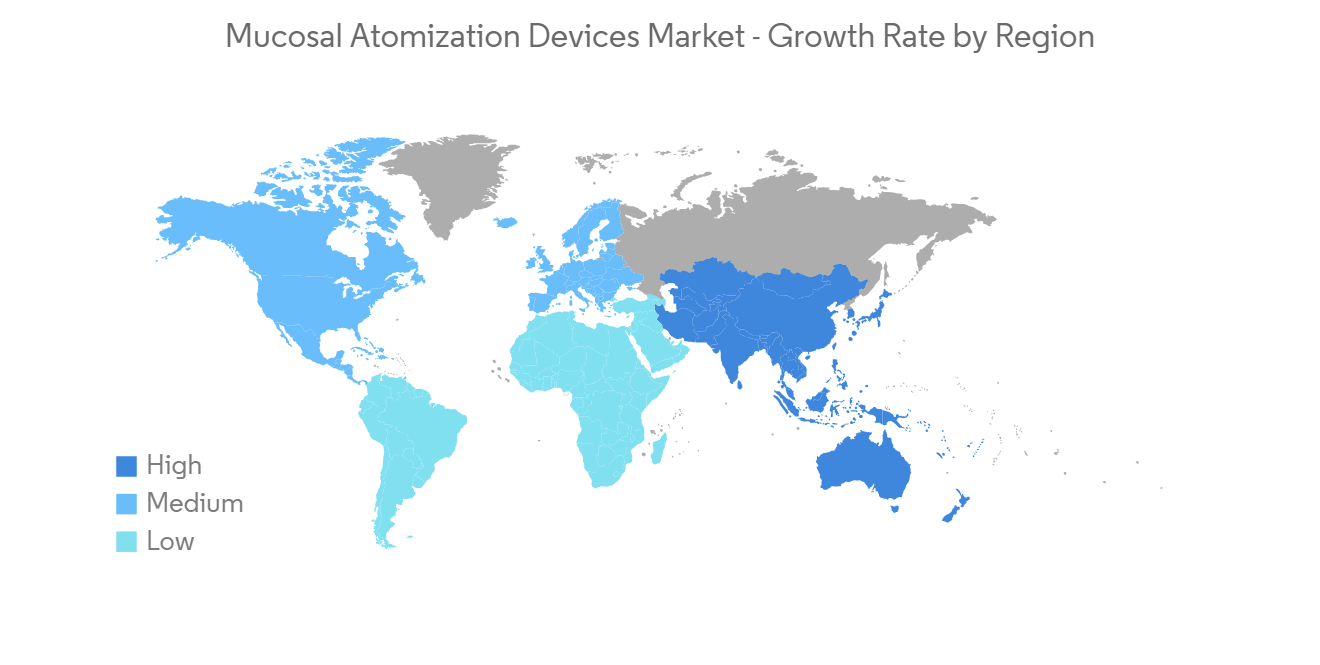 |
市場調查報告書
商品編碼
1273405
粘膜噴霧設備市場——增長、趨勢和預測 (2023-2028)Mucosal Atomization Devices Market - Growth, Trends, and Forecasts (2023 - 2028) |
||||||
※ 本網頁內容可能與最新版本有所差異。詳細情況請與我們聯繫。
粘膜噴霧設備市場預計在預測期內的複合年增長率約為 7.25%。
在早期階段,COVID-19 大流行對社區、行業和市場產生了負面影響,包括粘膜噴霧裝置。 例如,國際過敏和免疫學檔案館在 2021 年 1 月進行的一項調查發現,只有 13% 的醫生繼續使用非處方吸入劑提取物進行皮膚點刺試驗,而 31% 的醫生很少進行皮膚點刺試驗。 然而,所有人都被發現繼續服用治療哮喘和過敏性鼻炎的藥物,包括吸入皮質類固醇、長效 BETA2 受體激動劑、孟魯司特鈉、抗組胺藥和鼻用類固醇。 超過 92% 的醫生表示,他們開出吸入器作為對 COVID-19 患者的緊急反應。 在目前的情況下,隨著法規的放鬆,由於粘膜噴霧裝置在藥物輸送方面的優勢,市場預計會隨著粘膜噴霧裝置的採用而增長。 例如,根據 2022 年 2 月發表在 eBioMedicine 上的一篇論文,粘膜免疫可以在粘膜和全身水平誘導免疫反應。 九種針對不同粘膜感染的疫苗已獲准供人類使用,其中八種為口服疫苗,一種為鼻內 (IN) 疫苗,均為全病毒疫苗。
市場增長的主要驅動力是過敏性鼻炎、鼻竇炎和其他目標疾病在全球範圍內日益流行。 例如,根據 2022 年過敏資本報告,最常見的過敏性疾病之一是季節性過敏性鼻炎,通常稱為“花粉熱”。 在美國,大約 7.7% 的成年人和 7.2% 的兒童被診斷患有季節性過敏性鼻炎。 同樣,根據歐洲議會 2022 年 6 月的更新,過敏是歐洲最常見的慢性非傳染性疾病之一。 到 2022 年,歐洲將有約 1.5 億人患有過敏性鼻炎、哮喘、特應性濕疹和食物過敏等過敏性疾病。 因此,預計全球範圍內越來越多的過敏性疾病將增加對粘膜噴霧裝置的需求,從而推動市場的增長。
粘膜霧化器可以更快地將藥物輸送到血液中,從而減少治療劑對相關醫學問題起作用所需的時間。 因為這些藥物直接進入血液,它們避免了首過代謝並提供更快的結果。 此外,人群中癲癇患病率的增加導致引入粘膜霧化裝置,以便在緊急情況下通過鼻腔快速輸送藥物。 例如,2021 年 3 月發表在 Taylor 和 Francis 上的一篇論文證實,咪達唑侖粘膜鼻腔噴霧劑被迅速吸收,有助於阻止癲癇發作/癲癇症成人和兒童的癲癇發作活動。 這證明了患者通過粘膜霧化裝置對咪達唑侖鼻噴霧劑的耐受性,預計將增加對咪達唑侖鼻噴霧劑治療癲癇患者的需求並推動市場增長。
此外,粘膜霧化設備的技術進步和發展預計將促進市場增長,因為它們增加了便利性並促進了設備的採用。 例如,2021 年 10 月,Alcove Manufacturing and Distribution Inc. 和 Pulmodyne Inc. 合作擴大分銷、整合製造並繼續聯合研究新型霧化技術。 通過這一新的合作夥伴關係,Pulmodyne 通過現有渠道銷售了 EZ-Spray 霧化系統。 除了銷售之外,合作夥伴關係旨在進一步創新該領域,這種關係將使兩家經驗豐富的公司能夠快速優化產品設計。
在這些新興市場的發展中,預計藥物過量的副作用會抑制市場的增長。
粘膜霧化器市場趨勢
氣體推動的粘膜噴霧裝置預計將成為預測期內增長最快的部分
氣動或推進式藥物輸送系統是最早開發的系統之一。 氣體或空氣筒直接或通過管系統間接連接到噴槍,為噴射器活塞提供動力。 當觸發器被致動時,活塞被釋放,產生穿過鼻腔、面頰腔和氣管的藥物射流。 氣體泵送具有非常靈活的優點。 由於液化氣體種類繁多,一個容器可以承受各種壓力。 因此,可以使用一台儀器管理各種輸送選項,包括粘度(高達 300 cP 和更高的新技術)、劑量體積和主要容器差異。
此外,由於城市化、工業化以及隨之而來的生活方式的快速變化,空氣污染物的迅速增加導致因空氣污染引起的過敏症增加,如哮喘和過敏性鼻炎。 例如,根據IQAir 2022年3月發布的《世界空氣質量報告》,印度是全球117個國家、地區和領土中污染第五大的國家。 2021年,印度PM2.5年均值將達到58.1微克/立方米(microg/m3)。 因此,隨著空氣中過敏原的增加,治療需求預計會增加,這被認為將推動預測期內的市場增長。
此外,燃氣動力或推進式藥物輸送系統的技術進步和研發不斷增加,預計將推動該領域的增長。 例如,2021 年 1 月,Impel 的 5O5(b)(2) 新藥申請( NDA ) INP104 啟動,使用 Impel 專有的精確嗅覺遞送( POD )技術將雙氫麥角胺直接給藥到血管豐富的上鼻腔。 (DHE) 用於成人有或無先兆偏頭痛的急性治療。

預計在預測期內北美將佔據很大的市場份額
由於主要參與者的存在、過敏性鼻炎和鼻竇炎的高患病率以及完善的醫療保健基礎設施等因素,預計北美在預測期內將佔據全球市場的很大份額。 例如,根據 2022 年 AAFA 過敏之都報告,賓夕法尼亞州斯克蘭頓在美國排名第一的最差過敏之都。 此外,根據 2021 年加拿大哮喘報告,每天有 317 名加拿大人新診斷出患有哮喘。 超過 850,000 名 14 歲以下的兒童患有哮喘,使其成為加拿大兒童中最常見的慢性疾病之一。 因此,在預測期內,越來越多的哮喘和過敏性疾病病例將增加對粘膜噴霧裝置的需求。
此外,技術進步和使用粘膜霧化設備的臨床開發增加預計將推動市場增長。 例如,根據 2023 年 1 月發表在 PubMed 上的一篇論文,研究人員發現 M2-deficient single copies (M2SRs) 可能對高度漂移的 H3N2 流感病毒株的感染提供實質性保護。我已經證明這是不可能的。 在這項研究中,給藥使用粘膜噴霧裝置(MAD301;Teleflex),並製備最終稀釋液並通過吸入 1 mL 一次性聚丙烯注射器進行鼻內給藥。

粘膜噴灑器行業概況
粘膜霧化器市場競爭適中,參與者眾多。 目前主導市場的公司包括 Teleflex Incorporated、DeVilbiss Healthcare LLC、Becton、Dickinson and Company、Cook Group (Cook Medical) 和 Medica Holdings。
其他福利:
- Excel 格式的市場預測 (ME) 表
- 3 個月的分析師支持
內容
第一章介紹
- 調查假設和市場定義
- 本次調查的範圍
第二章研究方法論
第 3 章執行摘要
第四章市場動態
- 市場概覽
- 市場驅動因素
- 過敏性鼻炎、鼻竇炎和其他目標疾病的患病率增加
- 粘膜霧化器技術進展
- 市場製約因素
- 藥物過量引起的副作用
- 波特的五力分析
- 新進入者的威脅
- 買方/消費者議價能力
- 供應商的議價能力
- 替代品的威脅
- 競爭公司之間的敵對關係
第 5 章市場細分
- 按產品類型
- 氣體推進
- 電氣
- 最終用戶
- 醫院
- 醫務室
- 其他最終用戶
- 按地區
- 北美
- 美國
- 加拿大
- 墨西哥
- 歐洲
- 德國
- 英國
- 法國
- 意大利
- 西班牙
- 其他歐洲
- 亞太地區
- 中國
- 日本
- 印度
- 澳大利亞
- 韓國
- 其他亞太地區
- 世界其他地區
- 北美
第六章競爭格局
- 公司簡介
- Teleflex Incorporated
- DeVilbiss Healthcare LLC
- Becton, Dickinson and Company
- Cook Group
- Medica Holdings
- Integra LifeSciences
- BVM Meditech Private Limited
- Life-Assist Inc.
- BTME Group Limited(MEDTREE)
第七章市場機會與未來趨勢
The mucosal atomization devices market is projected to record a CAGR of nearly 7.25% over the forecast period.
During the initial phase, the COVID-19 pandemic adversely affected communities, industries, and markets, including mucosal atomization devices. For instance, as per a survey conducted by the International Archives of Allergy and Immunology in January 2021, only 13% of physicians continued skin prick testing with commercial inhalant extracts, while 31% of physicians performed skin pricking tests in rare cases. However, all the respondents were observed to be continuing their asthma and allergic rhinitis medication, including inhaled corticosteroids, long-acting Beta-2-agonists, Montelukast sodium, antihistamines, and nasal steroids. Over 92% of physicians reported prescribing inhaled medication to COVID-19 patients for instances of emergency management. In the current scenario, as the restrictions eased, the market is anticipated to witness growth because of the increase in the adoption of mucosal atomization devices due to the advantages offered by the devices in drug delivery. For instance, as per the article published in February 2022 in eBioMedicine journal, immune responses at the mucosal and systemic levels may be induced via mucosal immunization. Nine vaccines against different mucosal infections have been licensed for human use, including eight provided orally and one given intranasally (IN), all of which are complete viral vaccines.
The major factor contributing to the market growth is the increase in the prevalence of allergic rhinitis, sinus, and other target diseases across the world. For instance, as per the Allergy Capital Report 2022, one of the most common allergic conditions is seasonal allergic rhinitis, often called "hay fever." About 7.7% of adults and 7.2% of children have been diagnosed with seasonal allergic rhinitis in the United States. Similarly, as per the June 2022 update from European Parliament, allergies are among the most common chronic non-communicable diseases in Europe. In 2022, about 150 million people in Europe live with an allergic condition, such as allergic rhinitis, asthma, atopic eczema, or a food allergy. Hence, the rise in allergy diseases across the globe is anticipated to increase the demand for mucosal atomization devices, thereby driving market growth.
Mucosal atomization devices help in faster delivery of medication in the bloodstream, thus reducing the time for therapeutics to act on the concerned medical issue. As these drugs directly enter the bloodstream, they avoid first-pass metabolism and offer quicker results. Further, the increasing number of epilepsy cases among the population is increasing the adoption of mucosal atomization devices to quickly administer the drug intranasally in emergencies. For instance, according to an article published in Taylor and Francis, in March 2021, it had been observed that midazolam mucosal nasal spray rapidly absorbs, in adult and pediatric patients with seizures/epilepsy, and helps in terminating the seizure activity. This shows the viable tolerability of midazolam nasal spray through mucosal atomization devices in the patients which is expected to increase the demand for midazolam nasal spray for treating patients with epilepsy, thereby propelling the market growth.
Moreover, technological advancements and developments in mucosal atomization devices are expected to boost market growth since they increase convenience and thereby lead to the adoption of the devices. For instance, in October 2021, Alcove Manufacturing and Distribution Inc. and Pulmodyne Inc. collaborated to expand distribution, consolidate manufacturing, and continue cooperative research of novel atomization technologies. With this new partnership, Pulmodyne distributed the EZ-Spray Atomization System through its existing channels. In addition to distribution, the partnership seeks to innovate further in the space, and this relationship will allow the two experienced companies to optimize product designs quickly.
In the midst of these developments, side effects due to the overdose of drugs are expected to restrain the market growth.
Mucosal Atomization Devices Market Trends
Gas-propelled Mucosal Atomization Device is Expected to be a Fastest Growing Segment Over the Forecast Period
Gas-powered or propelled drug delivery systems were among the first developed systems. They use gas or an air cartridge attached to the gun either directly or indirectly through a tubing system to deliver power to the injector piston. When the trigger is activated, it releases the piston and creates a jet stream of medicant through the nasal and buccal passages and the trachea. Gas-propelled delivery offers the benefit of being extremely flexible. Owing to the variety of liquefied gases available, it's possible to provide a complete spectrum of pressure ranges within a single container format. This allows a single-device system to manage a variety of delivery options, including different viscosities (up to 300 cP and much higher with a new variation on the technology), injection volumes, and primary containers.
Furthermore, due to the rapid rise in urbanization, industrialization, and the resultant lifestyle changes, a steep rise in air pollutants has been observed to increase the number of allergies caused by air pollution, such as asthma, allergic rhinitis, and others. For instance, according to the World Air Quality Report, published by IQAir, in March 2022, India is the fifth most polluted country among 117 countries, regions, and territories around the world. The annual average PM2.5 levels reached 58.1 micrograms per cubic meter (micro-g/m3) in 2021, in India. Thus, with the rising airborne allergens, the need for treatment is expected to increase which in turn is expected to promote market growth over the forecast period.
Moreover, the rise in technological advances and research and developments in gas-powered or propelled drug delivery systems are expected to boost segment growth. For instance, in January 2021, the FDA accepted Impel's 5O5 (b)(2) New Drug Application (NDA) for INP104, a dihydroergotamine mesylate (DHE) delivered directly into the vascular-rich upper nasal space using Impel's proprietary Precision Olfactory Delivery (POD) technology, which is used for the acute treatment of migraine headaches with or without aura in adults.

North America Anticipated to Hold a Significant Share in the Market Over the Forecast Period
North America is expected to hold a significant market share in the global market throughout the forecast period due to factors such as the presence of key players, the high prevalence of allergic rhinitis and sinus in the region, and the established healthcare infrastructure. For instance, as per the AAFA allergy capital report 2022, Scranton in Pennsylvania ranked first for the worse-than-average allergy capital among others in the United States. Furthermore, as per the Asthma Canada 2021 report, every day, 317 Canadians are newly diagnosed with asthma. More than 850,000 children under the age of 14 have asthma, making it one of the most common chronic diseases among children in Canada. Hence, the rise in asthma and allergic disease cases increases the demand for mucosal atomization devices over the forecast period.
Moreover, the rise in technological advancements and clinical development utilizing mucosal atomization devices are likely to drive market growth. For instance, as per the article published in January 2023 in PubMed, the researchers demonstrated that the M2-deficient single replication (M2SR) might provide substantial protection against infection with highly drifted strains of H3N2 influenza. The study utilized a mucosal atomization device (MAD301; Teleflex) for dose administration and prepared the final diluted product, which was drawn into 1-mL disposable polypropylene syringes for intranasal delivery.

Mucosal Atomization Devices Industry Overview
The mucosal atomization devices market is moderately competitive and consists of several players. Some of the companies currently dominating the market are Teleflex Incorporated, DeVilbiss Healthcare LLC, Becton, Dickinson and Company, Cook Group (Cook Medical), and Medica Holdings.
Additional Benefits:
- The market estimate (ME) sheet in Excel format
- 3 months of analyst support
TABLE OF CONTENTS
1 INTRODUCTION
- 1.1 Study Assumptions and Market Definition
- 1.2 Scope of the Study
2 RESEARCH METHODOLOGY
3 EXECUTIVE SUMMARY
4 MARKET DYNAMICS
- 4.1 Market Overview
- 4.2 Market Drivers
- 4.2.1 Increasing Prevalence of Allergic Rhinitis, Sinus, and Other Target Diseases
- 4.2.2 Technological Advancement in Mucosal Atomization Devices
- 4.3 Market Restraints
- 4.3.1 Side Effects Due to Overdose
- 4.4 Porter's Five Forces Analysis
- 4.4.1 Threat of New Entrants
- 4.4.2 Bargaining Power of Buyers/Consumers
- 4.4.3 Bargaining Power of Suppliers
- 4.4.4 Threat of Substitute Products
- 4.4.5 Intensity of Competitive Rivalry
5 MARKET SEGMENTATION (Market Size by Value- USD Million)
- 5.1 By Product Type
- 5.1.1 Gas-propelled
- 5.1.2 Electrical
- 5.2 By End User
- 5.2.1 Hospitals
- 5.2.2 Clinics
- 5.2.3 Other End Users
- 5.3 Geography
- 5.3.1 North America
- 5.3.1.1 United States
- 5.3.1.2 Canada
- 5.3.1.3 Mexico
- 5.3.2 Europe
- 5.3.2.1 Germany
- 5.3.2.2 United Kingdom
- 5.3.2.3 France
- 5.3.2.4 Italy
- 5.3.2.5 Spain
- 5.3.2.6 Rest of Europe
- 5.3.3 Asia-Pacific
- 5.3.3.1 China
- 5.3.3.2 Japan
- 5.3.3.3 India
- 5.3.3.4 Australia
- 5.3.3.5 South Korea
- 5.3.3.6 Rest of Asia-Pacific
- 5.3.4 Rest of the World
- 5.3.1 North America
6 COMPETITIVE LANDSCAPE
- 6.1 Company Profiles
- 6.1.1 Teleflex Incorporated
- 6.1.2 DeVilbiss Healthcare LLC
- 6.1.3 Becton, Dickinson and Company
- 6.1.4 Cook Group
- 6.1.5 Medica Holdings
- 6.1.6 Integra LifeSciences
- 6.1.7 BVM Meditech Private Limited
- 6.1.8 Life-Assist Inc.
- 6.1.9 BTME Group Limited (MEDTREE)






